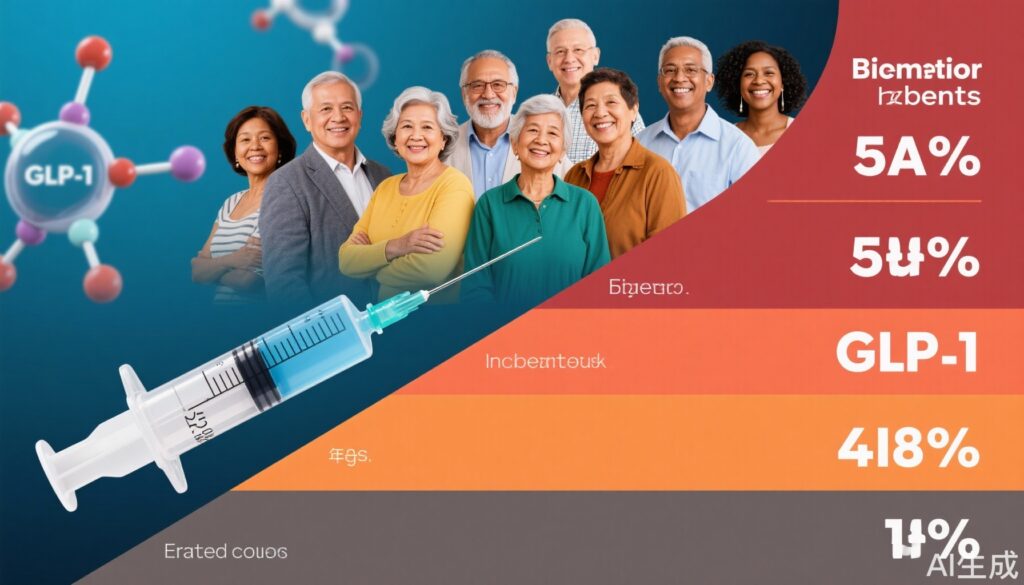Highlight
1. Injectable GLP-1 receptor agonist use among US adults with diabetes rose sharply from 4% in 2016 to nearly 27% in 2024.
2. Hispanic adults with diabetes had the highest usage rates (~31%) compared to other ethnic groups.
3. Usage was more prevalent in adults with overweight or obesity and in middle-aged groups (50-64 years).
4. No significant differences in injectable GLP-1 use were observed based on sex or family income.
Study Background and Disease Burden
Type 2 diabetes mellitus (T2DM) remains a substantial public health burden in the United States, affecting millions and driving significant morbidity and mortality due to macrovascular and microvascular complications. Effective glycemic control and weight management are central to reducing long-term adverse outcomes. Injectable glucagon-like peptide-1 receptor agonists (GLP-1 RAs) have emerged over the past decade as valuable therapeutic agents that improve glycemia, facilitate weight loss, and reduce cardiovascular risk. Despite well-documented efficacy, the real-world uptake and demographic patterns of GLP-1 RA use, particularly injectables, require ongoing surveillance to inform clinical guidelines and health policy.
Study Design
The data synthesis draws principally from longitudinal and cross-sectional nationally representative surveys — notably the Medical Expenditure Panel Survey Household Component (2016–2022) and the National Health Interview Survey (NHIS) with CDC data updates for 2024. These surveys encompass self-reported medication use among adults diagnosed with diabetes, capturing demographic variables (age, race/ethnicity, sex, income), clinical indices such as body mass index (BMI), and concomitant use of other diabetes medications. This observational approach provides robust epidemiologic insight into trends and disparities in GLP-1 injection use.
Key Findings
From 2016 to 2022, a striking increase occurred in injectable GLP-1 RA use, from approximately 4% to nearly 20%. Most recent 2024 data demonstrate that about 27% of adults with diabetes used these agents, often in combination with other glucose-lowering therapies.
Race and ethnicity influenced injectable GLP-1 use, with Hispanic adults having the highest prevalence (~31%), followed closely by non-Hispanic Black and non-Hispanic White adults (~26% each). Non-Hispanic Asian adults had substantially lower use rates (~12%). This suggests potential differences in access, provider prescribing patterns, or patient preferences that merit targeted interventions.
Age also correlated positively with use up to the 50–64 years range, where over one-third used GLP-1 injectables. Usage decreased after age 65, possibly reflecting comorbidities, polypharmacy concerns, or cost considerations in older populations.
Importantly, use was significantly greater among adults with overweight or obesity. Over 32% of adults with diabetes and obesity reported using injectable GLP-1 drugs, nearly double the rate of those with BMI less than 25, consistent with the recognized weight-lowering effects of GLP-1 RAs augmenting clinical utility in this subgroup.
No significant differences were detected by sex or family income level, indicating broad acquisition across socioeconomic strata.
While safety and tolerability were not the primary focus of this epidemiological data, clinical trials consistently document favorable profiles for injectable GLP-1s, with gastrointestinal side effects like nausea and vomiting as common adverse effects. The combination with other diabetes medications aligns with guideline recommendations for intensifying therapy to achieve glycemic targets.
Expert Commentary
These findings underscore the rapid integration of injectable GLP-1 receptor agonists into diabetes management paradigms. Their dual benefits on glycemic control and weight reduction provide a compelling rationale for expanded use, particularly amidst the obesity-diabetes nexus. The disproportionate usage among certain ethnic groups invites further research into cultural, socioeconomic, and healthcare system factors that influence medication adoption.
Notably, the decline in usage among those over 65 years warrants careful clinical evaluation. Elderly patients often have complex medical needs and may benefit from GLP-1 RAs’ cardioprotective properties, yet concerns about polypharmacy and renal function might deter prescribing. Clinicians should individualize therapy considering these factors and emerging evidence.
Limitations of the source data include self-reporting biases and lack of granularity on duration and adherence. Moreover, the impact of newer oral GLP-1 formulations remains to be seen as these enter the market and may influence injectable use patterns.
Conclusion
The upward trend in injectable GLP-1 receptor agonist use among US adults with diabetes reflects growing recognition of their therapeutic value. Nearly one-quarter of adults with diabetes now use these agents, notably among middle-aged, Hispanic, and obese populations. Ongoing surveillance and research focusing on barriers to equitable access and optimization in elderly patients are essential. These agents will likely maintain a central role in contemporary diabetes care, enhancing glycemic and weight management and potentially improving cardiovascular outcomes.
References
1. Schneider L. 1 in 4 US Adults With Diabetes Used Injectable GLP-1 Drugs Last Year. JAMA. 2025 Sep 5. doi: 10.1001/jama.2025.13363. Epub ahead of print. PMID: 40911319.
2. American Diabetes Association. Standards of Medical Care in Diabetes—2024. Diabetes Care. 2024;47(Suppl 1):S1-S305.
3. Buse JB, et al. Cardiovascular Risk Reduction with GLP-1 Receptor Agonists. Diabetes Care. 2020;43(9):2133-2143.
4. Nauck M, Meier JJ. Incretin Therapies: Pharmacology and Clinical Use. Diabetes Obes Metab. 2018;20 Suppl 1:5-16.



